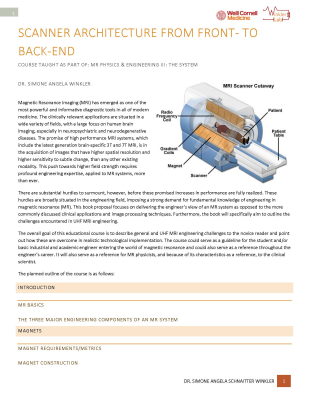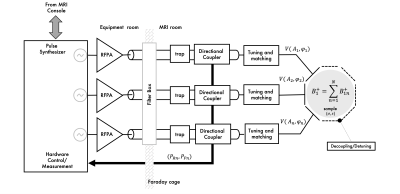Weekend Course
MR Physics & Engineering III: The System
Joint Annual Meeting ISMRM-ESMRMB & ISMRT 31st Annual Meeting • 07-12 May 2022 • London, UK

| MR System Overview | |||
| 07:45 |  |
Scanner Architecture from Front- to Back-End
Simone Angela Winkler
Magnetic Resonance Imaging (MRI) has emerged as one of the most powerful and informative diagnostic tools in all of modern medicine. The push towards higher field strength requires profound engineering expertise, applied to MR systems, more than ever. This course focuses on delivering the engineer’s view of an MR system as opposed to the more commonly discussed clinical applications and image processing techniques. The overall goal of this educational course is to describe general and UHF MRI engineering challenges to the novice reader and point out how these are overcome in realistic technological implementation.
|
|
| 08:10 | Magnet Design: Low Field Technologies
Shaoying Huang
The magnet designs for low-field accessible MRI will be detailed. It includes research work and design tools in the literature and industrial developments in history. Discussions and future perspectives will be shared.
|
||
| MR Receive Chain | |||
| 08:35 | RF Receive Chain OverviewAdam Maunder | ||
| 09:00 | RF Arrays for Head & Body
Nikolai Avdievich
Improvement of SNR is a critical step in designing any MRI RF coil. Use of arrays instead of a single coil is a major technique for the SNR enhancement. Designing an Rx-array commonly includes a choice of the type of elements (e.g. loops, striplines, dipoles), number of elements, decoupling method, coverage. The most common element of Rx-arrays is a surface loop, which has been used for human Rx-array designs at lower (1.5T, 3T) and ultra-high field (UHF, >7T). The presentation overviews most important steps of designing RF arrays including an optimization of the individual elements, decoupling, detuning, interfacing, cable routing.
|
||
| 09:25 | Break & Meet the Teachers |
||
| MR Transmit Chain | |||
| 09:50 |  |
RF Transmit Chain: Amplification, Power Transfer, B1 Control and SAR
Natalia Gudino
In this lecture, I will review design principles, implementation, and control of the radiofrequency (RF) hardware that generates the excitation B1 field in MRI scanners of various B0 field strengths.
|
|
| 10:15 |  |
Parallel Transmit (pTx) & Safety
Ehsan Kazemivalipour
A safe and efficient MRI test would rely on informed specification, design, implementation, assessment, and application of appropriately selected RF coils. Transmit array RF coils with multiple transmit elements provide the additional degrees of freedom that can be used to enhance field uniformity, while intending to mitigate SAR hotspots. Transmit array's performance can gain considerably from the parallel transmission technology when the array designs meet particular specifications, such as low coupling among individual array elements and appropriate interaction with subjects under test to provide a sufficient B1+ field efficiency.
|
|
| Gradients & Shims | |||
| 10:40 |  |
Gradient Coil Design Considerations & Limitations Including PNS
Mathias Davids
Designing an MRI gradient coil is a multi-objective problem that involves a variety of design targets. Aside from the gradient's primary function (generation of a linear gradient field), various other design constraints need to be imposed in order to generate a technically feasible coil geometry. This includes geometric constraints (dimensions of the coil), coil inductance and efficiency, torque/force balancing, wire spacing, Ohmic heating, as well as the overall manufacturability. This talk will give an intuitive overview of state-of-the-art tools for designing MRI gradient coils, including novel designs with reduced interactions with the human body (reduced Peripheral Nerve Stimulation, PNS).
|
|
| 11:05 | Shimming: Higher-Order Shims, Shim Arrays & Dynamic Shimming, Combined RF & Shim Coils
Ali Aghaeifar
Homogeneous static magnetic field (B0) is a prerequisite for many magnetic resonance imaging (MRI) applications. Scanners are equipped with a built-in spherical harmonic based shim setup to counteract B0 inhomogeneity. However, built-in shim setup might not be adequate for all applications, especially at UHF MRI where susceptibility induced B0 inhomogeneity is scaled with the strength of B0. Slice-wise shimming and multi-coil shim setup are some promising tactics that could significantly mitigate B0 inhomogeneity. This presentation will give an overview of the principle of SH-based, slice-wise, and multi-coil shimming and some details of each strategy will be discussed.
|
||
The International Society for Magnetic Resonance in Medicine is accredited by the Accreditation Council for Continuing Medical Education to provide continuing medical education for physicians.